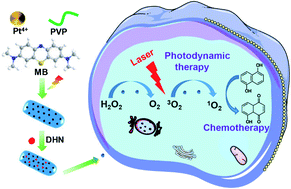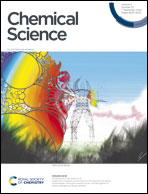Spatiotemporally controlled O2 and singlet oxygen self-sufficient nanophotosensitizers enable the in vivo high-yield synthesis of drugs and efficient hypoxic tumor therapy†
Abstract
Carrying out the in vivo syntheses of drugs toxic to tumors based on the specific features of the tumor microenvironment is critical for ensuring specific antitumor efficacy. However, achieving in situ high-yield synthetic toxic drugs from non-toxic agents and reducing their drug resistance in hypoxic tumors remain challenges. Herein we created a tumor-microenvironment-responsive porous Pt/Pt(IV) methylene blue coordination polymer nanoshuttle (Pt/PtMBCPNS) photosensitizer with spatiotemporally controlled O2 and singlet oxygen (1O2) self-sufficient for the in vivo high-yield synthesis of drugs and efficient hypoxic tumor therapy. After being endocytosed, the nanophotosensitizer as a cascade catalyst was observed to effectively catalyze the conversion of endogenous H2O2 to O2, and was hence found to play a dual role in the enhanced tumor therapy. PtMBCPNSs, upon being irradiated with red light, efficiently converted O2 into 1O2. Subsequently, 1O2 oxidized non-toxic 1,5-dihydroxynaphthalene to form the anticancer agent juglone with a high yield. In addition, O2 was found to be able to improve the hypoxic microenvironment without light irradiation, thus enhancing the antitumor efficacy of the produced drugs and reducing drug resistance. As a result, by enhancing the synergistic effect of the treatment, this nanophotosensitizer significantly inhibited the growth of tumors and avoided damage to normal tissues/organs. Collectively, this work highlights a robust nanoplatform with the spatiotemporally controlled in vivo high-yield synthesis of drugs and generation of O2 to help overcome the current limitations of chemical-based therapies against hypoxic tumors.



 Please wait while we load your content...
Please wait while we load your content...